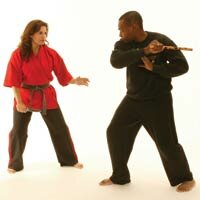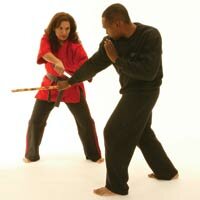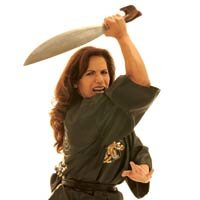|
Page 1 of 3

Knife against stick. Ready position (1)

Graciela meets the backhand strike with the blade (2)

She cuts the biceps (3)

then thrusts to the thigh (4)

|
Go ahead, try it. Just try to count on one hand the number of female martial artists who will be remembered long after this generation has thrown its last punch or unleashed its last kick. There's Rothrock and Bernal; Rijker and Rodriguez. And then there's Graciela Casillas, arguably the best and most influential female martial artist of all time.
Former kickboxing and boxing world champion; student to such greats as Dan Insoanto, Alfredo Bandalan and Angel Cabales; and the creator of a collegiate martial arts curriculum that has been accepted throughout California. For more than 30 years, Casillas has been the standard by which all female martial artists are judged.
Her career can be judged both by its excellence and longevity. Immortalized on magazine covers, infamous for an appearance in Playboy, Casillas always has done things her way. Ever the student, ever emptying her cup, Graciela continues to search for the meaning of her martial arts existence. As you read this, she will be making her first appearance at the World Stickfighting Championships in the Philippines. She has nothing left to prove; nothing she does in the motherland of her newest arte de jour will change the way we look at her accomplishments. It's never been about her, but rather what she could learn and pass onto others. Among female martial artists she remains the crown jewel. On the eve of possibly her stiffest martial arts test yet, Graciela Casillas sat down with Inside Kung-Fu to discuss how competing remains her raison d'etre.
INSIDE KUNG-FU: What attracted you to martial arts?
GRACIELA CASILLAS: When I originally got into martial arts, it had nothing to do with learning a particular style, but rather where I was at in my life. My parents were strict and didn't allow me to do much. I belonged to a church group and the church offered a tae kwon do class. Even though I didn't know anything about martial arts, I realized from the first class that this was something I was meant to do. Up to that point I had never done anything physical-no sports, dance, nothing.
IKF: What was it about martial arts that lit a fire inside you?
GC: I just embraced it. It was a strange feeling, but I just enjoyed it. The energy was incredible. I trained for about a year and a half with this really intense instructor. It laid the groundwork for all my future training and set the stage for what I would expect in the future. It was a matter of "ignorance is bliss." He was ex-military and very extreme. We wore Army fatigues and did knuckle push-ups on concrete. After six months we got kicked out of the church because we left footprints on the walls. Our training never consisted of forms, just full-contact sparring usually with no protective equipment. I would come home with lumps on my instep. I just figured that's the way everyone did it. I took a beating but still believed there was excitement to the contact, the training, the sense of adventure.
IKF: You eventually turned to the Korean art of hwarang do. What happened?
GC: The class was so tough that the numbers dwindled from 30 to 3 and then finally disbanded. I liked the forms of hwarang do, but the style did not advocate competition. I was a red belt teaching other students basics and I realized I wasn't progressing.
IKF: How did you handle that?
GC: I discovered a kenpo karate studio down the street and would run from my hwarang do school. I missed the competition, missed the contact. The kenpo was more like real training, and even though I valued what I was learning in hwarang do, there was no spine to it. The kenpo school was participating in full-contact. Although I was teaching, I needed to know if what I was teaching was real. I had no arena to test it. When I got into the ring it was almost anticlimactic. The process that led to it was the real joy. I enjoyed training, getting in shape and developing myself.
IKF: Your travails as a professional kickboxer are legendary. You retired as one of the greatest female fighters of all time. What do you remember about those days?
GC: Fights were few and far between, and the way we were treated was not very good. But I still had that hunger to compete. I would see the way men were treated and the way men were paid and while we never received anything close to the same respect, my desire to become world champion kept me going. I had done maybe 50 television appearances and had fought all over the world, but the old joke was, "I have enough newspaper and magazine articles to wallpaper my apartment but not enough money to pay my rent." Finally I got tired of fighting for $100 a round or maybe making $3,000 for a fight. And I got tired of my trainer, Jimmy Montoya, telling me, "Graciela, if you only were a man. You pick up techniques so quickly; you can do so many things a man can't. Yet the only reason you're fighting is that people are doing me a favor." It was very discouraging.
IKF: So you turned back to traditional martial arts?
GC: Yes. Paul Maslak, a friend [and former editor of IKF], introduced me to Danny Inosanto. When I walked into his school I just knew that I belonged there. The more I trained, the more I learned. I hung up my gloves, got my master's degree in educational psychology and counseling and started teaching school. My heart wasn't in it; that was my safety net.
IKF: But it seems as though you've never followed the "safe" approach.
GC: I have evolved myself to a point where in the next decade I will dedicate my efforts to being the best I can be. I need to make sure I leave no stone unturned. I want to be at the forefront of teaching martial arts, whether it is weapons or self-defense. I want to make sure that the quality of what I am teaching is real and that the principles are sound. Take, for example, Bruce Lee's analogy of a lump of clay. When you sculpture something you don't add more clay. You mold it, refine it and add your own personal touches.
IKF: Do you consider yourself a female first or a martial artist first?
GC: I see myself as a martial artist first, but I don't deny that I am different from a male. I don't believe in competing against men. During my years as a professional kickboxer and boxer you would occasionally hear women either say they were as good as men or actually try to prove it. But to me, we're different, and more importantly, we're at different stages in the evolution of martial arts. For that reason, my training partners have always been men, because they are more evolved in a martial arts sense. I had 32 professional fights and not once did I train with a female. I believe I excelled because I had access to professional men.
IKF: Despite your stature, you are among martial arts' most controversial figures.
GC: I think much of that came from my appearance in Playboy in 1983. The same year I appeared on the cover of Fighting Stars magazine I also was featured in Playboy. That decision stirred up a lot of controversy and created a lot of resentment, especially among women's groups.
<< Start < Previous 1 2 3 Next > End >>
|